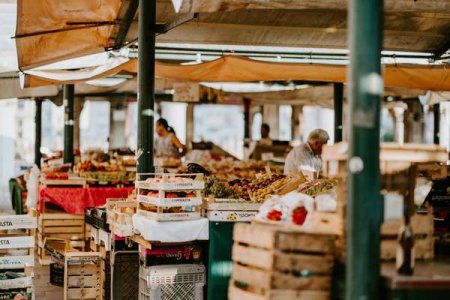Slash your grocery bill now: 5 smart swaps to outsmart rising tariff costs!
- Replies 0
As the winds of trade shift and tariffs loom on the horizon, the savvy shopper must navigate the changing tides of the grocery landscape.
With new tariffs set to impact the cost of imported goods from our neighbors to the north and south, it's time to hoist the sails and chart a course towards budget-friendly waters.
Today, we're diving into the pantry to uncover five ingenious grocery swaps that can help you sidestep those pesky tariff-induced price hikes.
Starting April 2, the US is bracing for a 25% tariff on a variety of products from Canada and Mexico, with the possibility of further taxes on goods from other countries.
This could spell trouble for your wallet, as a significant portion of our fruits and vegetables are imported from these regions.
But fear not! We've got a treasure trove of strategies to help you keep your grocery costs from capsizing.

1. Set Sail for the Farmers Market
With Mexico supplying over half of the US imported fruits and a whopping 69% of veggies, your local grocery store's produce section might soon feel the squeeze. But there's a bountiful harvest to be found closer to home.
Embrace the farmers market, where local growers offer a variety of seasonal delights. You'll not only dodge the tariff bullet but also discover the joys of eating fresh and supporting your local economy.
2. Chart a New Course with Syrup
Maple syrup, a staple of breakfast tables everywhere, may soon see a price surge, with Canada being the world's largest producer. But who says you can't sweeten your morning with a twist?
Explore the waters of local honey, or venture into the realms of cane or date syrup. Better yet, embark on a culinary adventure and craft your own fruit-based syrup. Your pancakes will thank you for the upgrade.

3. Navigate the Baking Aisle
The tariff storm could hit your favorite imported cookies and wafers hard. Before you abandon ship, consider taking the helm in your own kitchen.
Baking your own treats not only saves you from the tariff tempest but also adds a personal touch to your snacks. Who knows? You might just discover a new favorite recipe that's even better than the store-bought variety.
4. Discover New Ports of Wine
While tariffs on European wines are still just a whisper on the wind, it's the perfect opportunity to explore domestic vineyards.
From the rolling hills of California to the hidden gems of New York's Finger Lakes, the US is home to a diverse array of wine regions waiting to be discovered. Or set your sights on international waters with wines from Australia, New Zealand, or South Africa.
You might be interested: New trade tariffs could spike grocery prices—here’s how to stay ahead
5. Bulk Up on Savings
The tariffs aren't just targeting your food—they're also taking aim at the packaging. With increased costs on aluminum and plastic, those canned goods and pre-packaged snacks might see a hike.
But there's treasure to be found in the bulk bins, where you can stock up on everything from spices to dried fruit without the added cost of packaging. Bring your own containers and watch the savings pile up.
While the tariff tides are inevitable, your journey through the grocery aisles doesn't have to be a perilous one.
By shopping locally, embracing seasonality, and taking a more hands-on approach to your pantry, you can weather the storm without sacrificing flavor or quality. Remember, every swap you make is a step towards a more resilient and resourceful lifestyle.
Also read: How Trump's tariffs could impact your wallet: What you need to know

What swaps have you made to keep your bills at bay? Share your stories and tips in the comments below!
With new tariffs set to impact the cost of imported goods from our neighbors to the north and south, it's time to hoist the sails and chart a course towards budget-friendly waters.
Today, we're diving into the pantry to uncover five ingenious grocery swaps that can help you sidestep those pesky tariff-induced price hikes.
Starting April 2, the US is bracing for a 25% tariff on a variety of products from Canada and Mexico, with the possibility of further taxes on goods from other countries.
This could spell trouble for your wallet, as a significant portion of our fruits and vegetables are imported from these regions.
But fear not! We've got a treasure trove of strategies to help you keep your grocery costs from capsizing.

US tariffs on products from Canada and Mexico are set to take effect on April 2, which could impact prices on imported fruits and vegetables. Image source: Annie Spratt / Unsplash.
1. Set Sail for the Farmers Market
With Mexico supplying over half of the US imported fruits and a whopping 69% of veggies, your local grocery store's produce section might soon feel the squeeze. But there's a bountiful harvest to be found closer to home.
Embrace the farmers market, where local growers offer a variety of seasonal delights. You'll not only dodge the tariff bullet but also discover the joys of eating fresh and supporting your local economy.
2. Chart a New Course with Syrup
Maple syrup, a staple of breakfast tables everywhere, may soon see a price surge, with Canada being the world's largest producer. But who says you can't sweeten your morning with a twist?
Explore the waters of local honey, or venture into the realms of cane or date syrup. Better yet, embark on a culinary adventure and craft your own fruit-based syrup. Your pancakes will thank you for the upgrade.

Shoppers are advised to consider local options such as farmer's markets and alternative syrup choices, as well as bulk buying to avoid increased costs due to tariffs. Image source: Theme Photos / Unsplash.
3. Navigate the Baking Aisle
The tariff storm could hit your favorite imported cookies and wafers hard. Before you abandon ship, consider taking the helm in your own kitchen.
Baking your own treats not only saves you from the tariff tempest but also adds a personal touch to your snacks. Who knows? You might just discover a new favorite recipe that's even better than the store-bought variety.
4. Discover New Ports of Wine
While tariffs on European wines are still just a whisper on the wind, it's the perfect opportunity to explore domestic vineyards.
From the rolling hills of California to the hidden gems of New York's Finger Lakes, the US is home to a diverse array of wine regions waiting to be discovered. Or set your sights on international waters with wines from Australia, New Zealand, or South Africa.
You might be interested: New trade tariffs could spike grocery prices—here’s how to stay ahead
5. Bulk Up on Savings
The tariffs aren't just targeting your food—they're also taking aim at the packaging. With increased costs on aluminum and plastic, those canned goods and pre-packaged snacks might see a hike.
But there's treasure to be found in the bulk bins, where you can stock up on everything from spices to dried fruit without the added cost of packaging. Bring your own containers and watch the savings pile up.
While the tariff tides are inevitable, your journey through the grocery aisles doesn't have to be a perilous one.
By shopping locally, embracing seasonality, and taking a more hands-on approach to your pantry, you can weather the storm without sacrificing flavor or quality. Remember, every swap you make is a step towards a more resilient and resourceful lifestyle.
Also read: How Trump's tariffs could impact your wallet: What you need to know
Key Takeaways
- US tariffs on products from Canada and Mexico are set to take effect on April 2, which could impact prices on imported fruits and vegetables.
- Shoppers are advised to consider local options such as farmer's markets and alternative syrup choices, as well as bulk buying to avoid increased costs due to tariffs.
- Homemade baking and cooking could provide savings, with the potential rise in price of imported biscuits, wafers, and other treats.
- Exploring local wine options and utilising bulk bins for dry goods may help consumers save money in response to tariffs affecting food packaging materials like aluminium and plastic.
What swaps have you made to keep your bills at bay? Share your stories and tips in the comments below!






